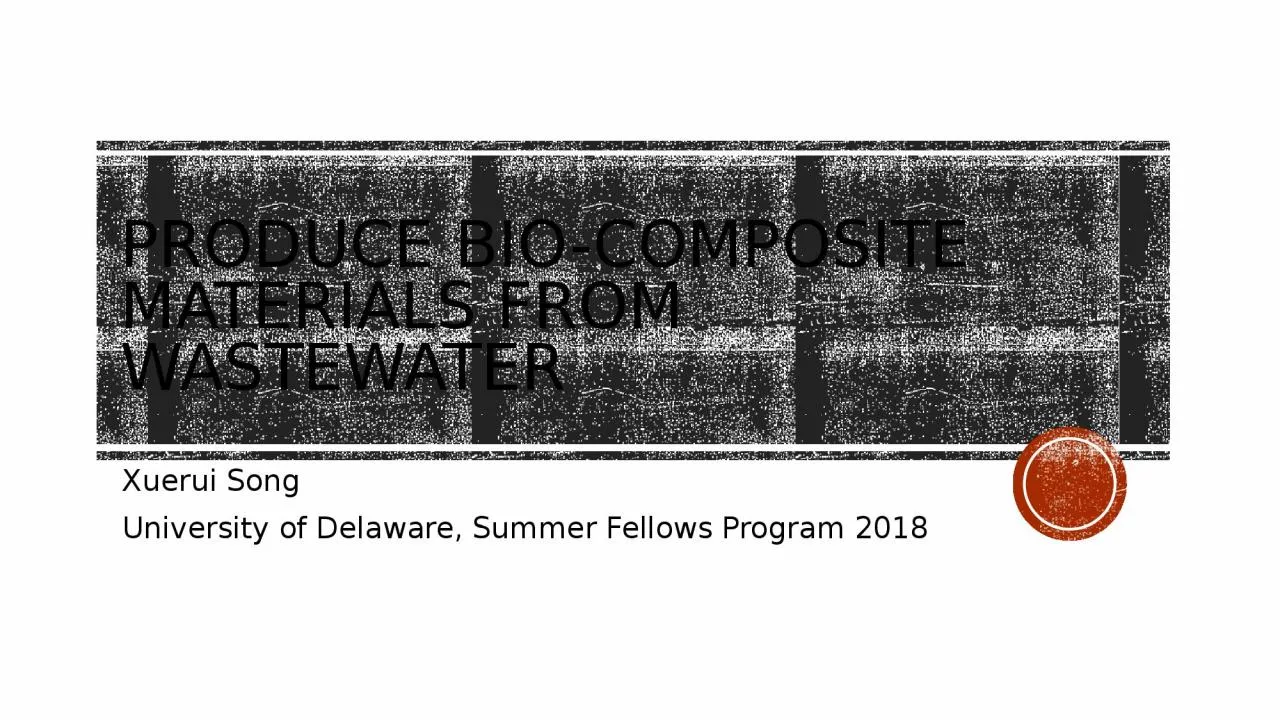

Xuerui Song University of Delaware Summer Fellows Program 2018 About This project Work under Professor Daniel Cha Department Civil amp Environmental Engineering Project leader Xiangmin ID: 1040382
Download Presentation The PPT/PDF document "Produce bio-composite materials from wa..." is the property of its rightful owner. Permission is granted to download and print the materials on this web site for personal, non-commercial use only, and to display it on your personal computer provided you do not modify the materials and that you retain all copyright notices contained in the materials. By downloading content from our website, you accept the terms of this agreement.
1. Produce bio-composite materials from wastewaterXuerui Song University of Delaware, Summer Fellows Program 2018
2. About This project Work under Professor Daniel Cha Department: Civil & Environmental Engineering Project leader: Xiangmin LiangObjective (from Liang’s report): To evaluate the potential for using both “filamentous” wastewater microorganisms (as reinforcement) and polyhydroxyalkanoates (PHA)-accumulating wastewater microorganisms as biorenewable matrix for compositesTo identify filamentous bacteria that have favorable properties for using as a reinforcement in a biocomposite
3. filamentous bacteria filamentous bacteria are components of activated sludge biomass which form the important part of floc formation when they connect to each other and cause the removal of sediment from the fluid.This image exhibits what filamentous bacteria look like under 20x optical microscope
4. PHAPolyhydroxyalkanoates or PHAs are made up of a group of natural biodegradable polyesters that are synthesized by numerous microorganisms.Two common types of PHA are Polyhydroxybutyrate (PHB) and polyhydroxyvalerate (PHV)Biodegradable, environmental friendly and biocompatible thermoplastics About 300 kinds of bacteria accumulate PHA as storage productsSource: https://en.wikipedia.orgPHA Structure
5. Three types of reactors in the lab 1. Membrane Bioreactor (MBR)One form of the activated sludge processMembrane as a physical barrier for separationBacteria are selected based on long main cell residence time and low COD from wastewater treatment plant2. Sequencing Batch Reactor (SBR)One form of the activated sludge processPhase separation used to separate the mixed liquor from the wastewaterBacteria are selected based on shorter main cell residence time and higher COD from wastewater treatment plant3. Fed Batch Reactor (FBR)Used in fermentationCyclical feeds and extractionsRemain bacteria (inoculation from SBR system) in the reactor
6. Membrane BioreactorSequencing Batch ReactorFed Batch Reactor
7. Structure of MBR
8. timeline of SBR12:30 pm -1:30 pm: settling, turn off the pH controller, air pump, stirring plate and decant pump1:30 pm -2:00 pm: decant2:00 pm – 2:10 pm: refill reactor to 3L by using fill pump from the media container2:10 pm – 12:30 pm (next day): react
9. My WorkMake sure there is enough media for each system (SBR consumes 2.5 L media per day, MBR consumes 6 L media per day)Do Total Suspended Solids (TSS) test for SBR effluent, SBR solution, MBR solution and FBR solution every day to calculate the wasteDo Volatile Suspended Solids test for SBR effluent, SBR solution, MBR effluent, MBR solution and FBR solution every Tuesday Measure anion concentration in SBR and MBR effluent every WednesdayMeasure Total Organic Carbon in FBR every day Samples for TSS test
10. Current stage – PHB ExtractionSuccessfully culture filamentous bacteria in reactors, FBR has the most Polyhydroxybutyrate (PHB), a common type of PHA, is a biodegradable plastic.Filamentous bacteria is one kind of PHB accumulated bacteria and produce PHB when they are hungry Glucose is the feed for FBRMain goal is to test the practicability of the extraction Result: We did at least 5 times of PHB extraction, but only got final product twice
11. PHB Extraction procedure 1. Take 25 ml mixed liquor into tube and centrifuge 2. Waste supernatant and add 25ml DI water, mix through 3. Add 0.2 g of sodium dodecyl sulfate and 0.18 g EDTA in to the tube 4. Autoclave the mixed liquor under 121 oC for 30 minutes5. After autoclaving, centrifuge6. Waste supernatant and add 25 ml of DI water into centrifugation tube and mix thoroughly7. Centrifuge8. Waste supernatant and add 1 ml of DI water into centrifugation tube and mix thoroughly9. Add 10 ml of acetone into centrifugation tube and mix thoroughly10. The mixed liquor is filtered in a Buchner funnel and wash with DI water for 3 times then rinse with acetone then let it dry11. The filter paper is put into a 150 ml glass baker, add 0.02 g of celite filtering agent and 30 ml of chloroform, then boil to boiling for 1 minute12. The entire solution is filtered in a Buchner funnel 13. Repeat step 11 and 12 twice, collect all the filtrate14. All the filtrate is boil to boiling until total volume is about 30 ml and allowed to cool for 5 minutes15. Add 15 ml of methanol into cooled filtrate and is filtered in a Buchner funnel then rinse with acetone then allow to dry16. Peel the PHB from filter paper
12. Future work Short term: adjust the frequency and amount of glucose that add in to FBR Long term:PHA will be generated and recovered from lab-scale reactors that have been designed to enrich for PHA-rich biomassFilamentous bacteria isolated from mixed microbial consortia will be individually tested for strength and toughness for the selection of ideal reinforcement agents. Biocomposites will be manufactured by combining the biopolymer and reinforcing filaments. Polymers and composites will be tested to determine their thermal and mechanical properties, and morphology.
13. AcknowledgementDr. Daniel Cha Xiangmin Liang Inyoung Kim Dr. Yu-Han Yu